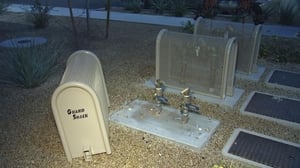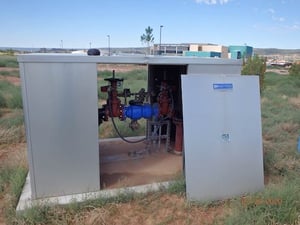In many cities across the United States, there is a growing popularity to install the RPZ backflow preventer outside the building and above ground. Backflow preventers have historically been installed in below-grade vaults or inside the building. Neither of these installation locations is the best practice due to safety and flood risks. Installing the backflow preventer outside the building, above ground and in a backflow cover is the right thing to do. In this blog, we’ll review the three most important things backflow enclosures provide: protection from vandalism, protection from freezing, and an improvement of the aesthetics.
Backflow Cover: Protection from Vandalism
 Theft is a common occurrence. A thief will steal when they can see and take something that requires little effort. There are stories told of truckloads of small diameter backflow preventers showing up at scrap yards. A backflow preventer needs a backflow cover so that the thief will not know what’s inside. As a comparison, backflow cages and/or the absence of a cover make it much easier for the thief to steal it because they can see it and see inside it.
Theft is a common occurrence. A thief will steal when they can see and take something that requires little effort. There are stories told of truckloads of small diameter backflow preventers showing up at scrap yards. A backflow preventer needs a backflow cover so that the thief will not know what’s inside. As a comparison, backflow cages and/or the absence of a cover make it much easier for the thief to steal it because they can see it and see inside it.
Backflow Cover: Protection from Freezing
 A backflow cover provides insulation and heat to prevent the backflow preventer from freezing during cold weather. During the winter of 2021, many southern states experienced a prolonged period of cold weather. The backflow preventers that were installed without an enclosure or those that were installed inside a cage froze. When this happens, the building does not have water and the backflow preventer is damaged, which results in an expensive replacement. Getting a contractor to repair this also takes time. Most businesses need water to be open. A frozen backflow can have a negative impact on the success of the business. Failing to install a backflow cover with heat in the south is a penny-wise and pound-foolish decision.
A backflow cover provides insulation and heat to prevent the backflow preventer from freezing during cold weather. During the winter of 2021, many southern states experienced a prolonged period of cold weather. The backflow preventers that were installed without an enclosure or those that were installed inside a cage froze. When this happens, the building does not have water and the backflow preventer is damaged, which results in an expensive replacement. Getting a contractor to repair this also takes time. Most businesses need water to be open. A frozen backflow can have a negative impact on the success of the business. Failing to install a backflow cover with heat in the south is a penny-wise and pound-foolish decision.
Backflow Cover: Improves Aesthetics
 In many southern states, backflow preventers are installed outside the building and above ground. This is the best practice location. In addition to the freezing risk mentioned previously, without an enclosure to cover the backflow preventer, the aesthetics are very poor. Nice-looking buildings with an exposed backflow preventer... The electrical transformer and dumpster get consideration for aesthetics and so should the backflow preventer. Adding a backflow cover to the backflow assembly creates a more pleasing view aesthetically. This view can also be further improved with placement, color, wraps or landscaping. Check out this guide for suggestions on improving the view.
In many southern states, backflow preventers are installed outside the building and above ground. This is the best practice location. In addition to the freezing risk mentioned previously, without an enclosure to cover the backflow preventer, the aesthetics are very poor. Nice-looking buildings with an exposed backflow preventer... The electrical transformer and dumpster get consideration for aesthetics and so should the backflow preventer. Adding a backflow cover to the backflow assembly creates a more pleasing view aesthetically. This view can also be further improved with placement, color, wraps or landscaping. Check out this guide for suggestions on improving the view.
A backflow cover is essential when the backflow preventer is installed outside the building and above ground. The cover provides protection against vandalism, protection from freezing, and enhances aesthetics.




